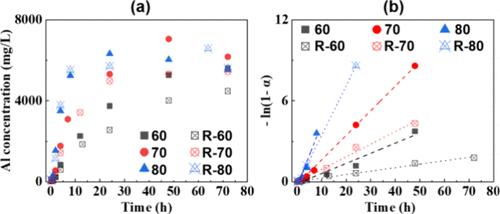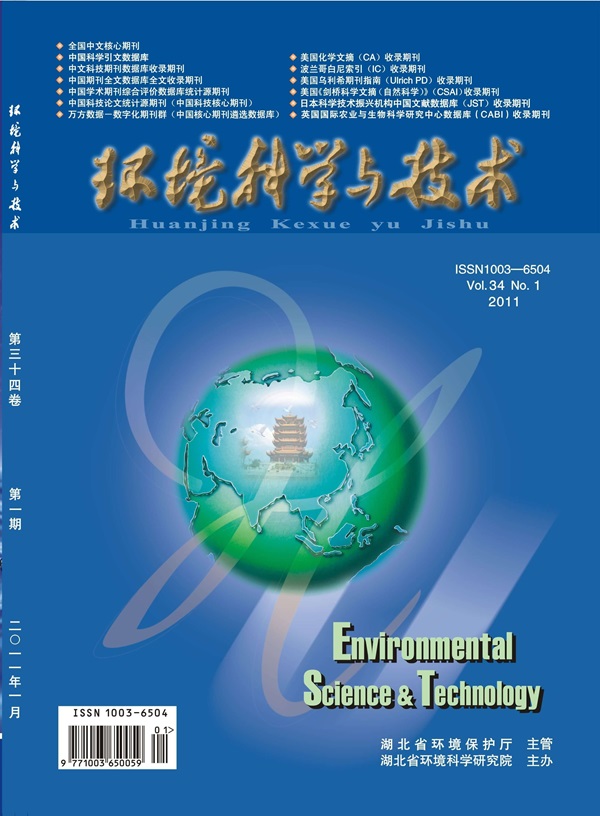Effect of 60Co Irradiation on Boehmite Dissolution in Caustic Solutions
IF 11.3
1区 环境科学与生态学
Q1 ENGINEERING, ENVIRONMENTAL
引用次数: 0
Abstract
Here, we examine how radiation impacts the dissolution behavior of boehmite by subjecting dry nanoparticles of different sizes to 60Co γ radiation and subsequently analyzing their dissolution behavior in caustic solutions as a function of temperature. The measured kinetics show that irradiation with an amount 228.24 Mrad significantly slows the dissolution rate, particularly for smaller sizes at lower temperatures. Specifically, the temperature-dependent dissolution rates of irradiated 20 nm boehmite versus pristine material in 3 M NaOH solutions were several times lower (e.g., rate constant of 0.026 vs 0.075 h–1 at 60 °C), with an apparent activation energy 40 kJ mol–1 higher. Although various imaging techniques and X-ray diffraction measurements consistently revealed no obvious differences between pristine and irradiated samples, after irradiation significant binding energy shifts were detected in the X-ray photoelectron Spectroscopy peaks of Al 2p and O 1s, and a change in their relative intensities indicated a lower O/Al ratio. This suggests that γ-irradiation may stabilize boehmite particle surfaces by driving their chemistry and structure toward more stable aluminum oxide forms. This finding may help explain slower dissolution rates of boehmite in nuclear waste and may be useful for the development of more robust predictive models and effective strategies for waste processing.

60Co 辐照对苛性钠溶液中沸石溶解的影响
在这里,我们将不同尺寸的干纳米颗粒置于 60Co γ 辐射下,然后分析它们在苛性碱溶液中的溶解行为与温度的函数关系,从而研究辐射如何影响沸石的溶解行为。测量的动力学结果表明,辐照量为 228.24 Mrad 的辐照会显著降低溶解速率,尤其是在较低温度下对较小尺寸的纳米颗粒而言。具体地说,在 3 M NaOH 溶液中,经辐照的 20 纳米玻镁石的溶解速率比原始材料低几倍(例如,60 °C 时的速率常数为 0.026 h-1 与 0.075 h-1),表观活化能高出 40 kJ mol-1。虽然各种成像技术和 X 射线衍射测量始终显示原始样品和辐照样品之间没有明显差异,但在辐照后,在 Al 2p 和 O 1s 的 X 射线光电子能谱峰中检测到明显的结合能移动,其相对强度的变化表明 O/Al 比率降低。这表明,γ-辐照可能会使沸石颗粒表面的化学和结构趋向于更稳定的氧化铝形式,从而使其更加稳定。这一发现可能有助于解释核废料中沸石溶解速度较慢的原因,并有助于开发更可靠的预测模型和制定有效的废料处理策略。
本文章由计算机程序翻译,如有差异,请以英文原文为准。
求助全文
约1分钟内获得全文
求助全文
来源期刊

环境科学与技术
环境科学-工程:环境
CiteScore
17.50
自引率
9.60%
发文量
12359
审稿时长
2.8 months
期刊介绍:
Environmental Science & Technology (ES&T) is a co-sponsored academic and technical magazine by the Hubei Provincial Environmental Protection Bureau and the Hubei Provincial Academy of Environmental Sciences.
Environmental Science & Technology (ES&T) holds the status of Chinese core journals, scientific papers source journals of China, Chinese Science Citation Database source journals, and Chinese Academic Journal Comprehensive Evaluation Database source journals. This publication focuses on the academic field of environmental protection, featuring articles related to environmental protection and technical advancements.
 求助内容:
求助内容: 应助结果提醒方式:
应助结果提醒方式:


